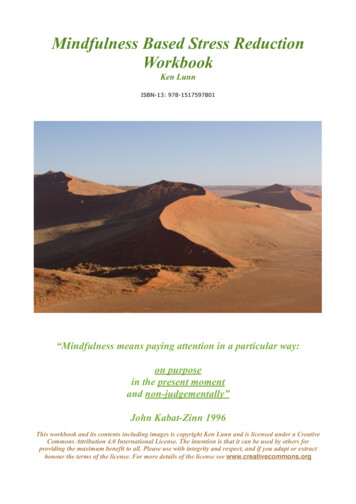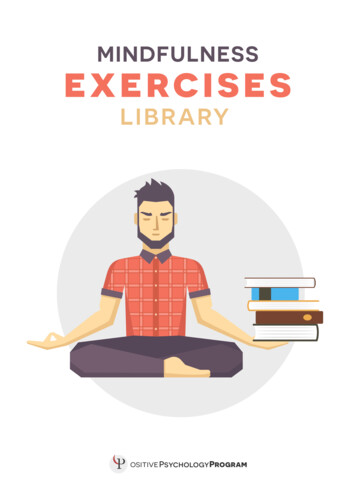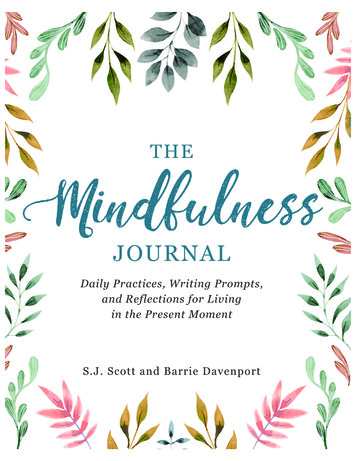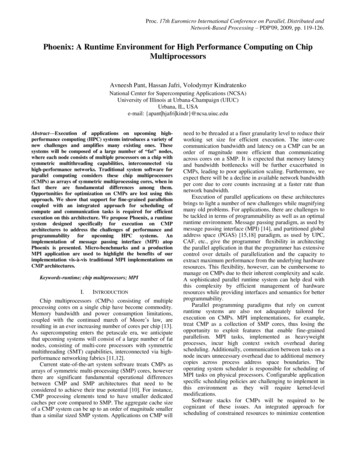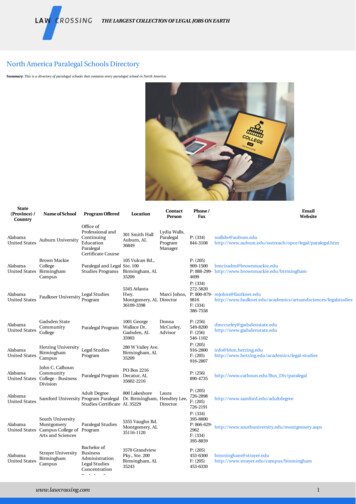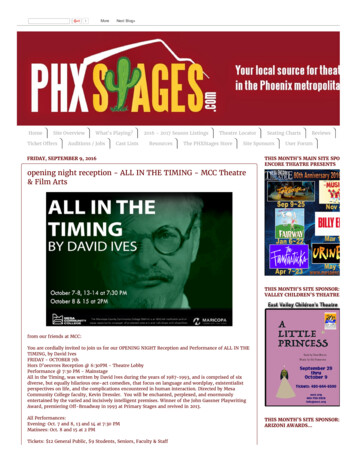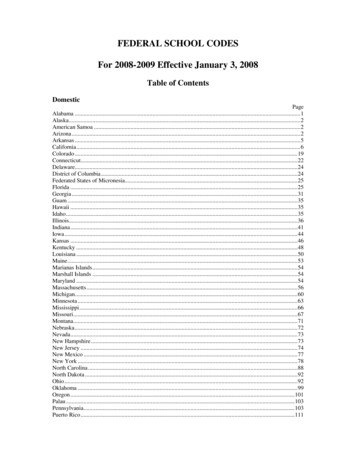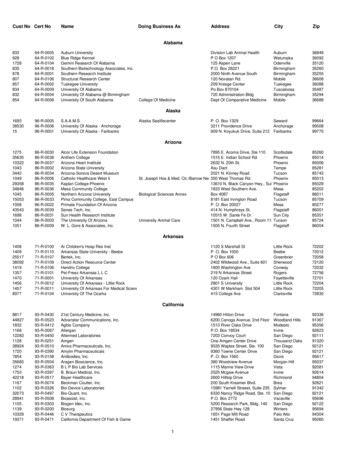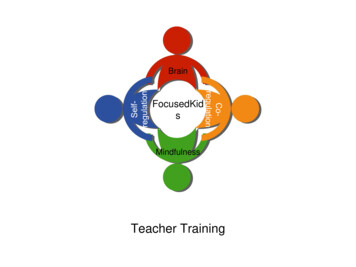
Transcription
BrainFocusedKidsMindfulnessTeacher Training
Welcome to FocusedKids 1. Intro Beginning With You The Developing Brain The Puppets The Calm Down Basket and Calm Down Corner Intro to self-regulation and co-regulation2. Taming the Dragon - recovering from meltdownsMindful activities for co-regulation and Self-regulation3. Pausing Your ClassroomMindful Classroom Exercises - daily practice4. On-going - FK newsletter, using resources, formown group to meet and practiceyour
1. A simple curriculumexercisesWhat isofmindfulFocusedKids?2. For ages 0-53. Teaches kids, parents, and teachersabout their brains,4. The skills for co-regulation, and selfregulation.5. A simpleexercisescurriculumofmindful6. For ages 0-57. Teaches kids, parents, and teachersabout their brains,8. The skills for co-regulation, and selfregulation.www.focusedkids.org
Why FocusedKids?Developed specifically forpreschool ages, FocusedKidssupports adults and children inmastering the developmentalsteps of:1. Managing emotions2. Controlling bodies3. Maintaining focus andattention on a taskThese are the executive functionskills of self-regulation, and arefoundational for all otherlearning.
What We DoFirst we teach kids about theirbrains using puppets torepresent three key parts.For the 0-3 population weteach parents the same lesson.
What You Can DoLearn the basics about the brainLearn and use short mindful strategies to your advantagePractice “brain breaks” every dayLearn the basics about the brainLearn and use short mindful strategies to your advantagePractice “brain breaks” every day
The brain is born wired for potential it needs experiences to shape the outcomes.It is growing fastest, and is most pliable between the ages of 0-5
Brain Lesson Videohttps://vimeo.com/268423906Kids feel empowered to be in charge of their brain!
What’s going on in there?The 0-5 Brain We are building the foundation of the brain architecture Tantrums: the still-developing brain is overwhelmed by mental demands We’ll actually delay development of their intelligence if we stressthem out with unrealistic expectations. The neurological processing in the three-to-five-year old’s brain istwice as busy as that of a college student, and maybe adults! A preschooler has 100 billion brain cells (neurons), with 77%in the cerebral cortex The neurons are forming connections which transmit informationfrom neurons to other cells .eventually 1,000 trillion!
The result of this massive mental exertion?Raging typhoons of bewildering datastorm and flood the preschooler’s brain.Dikes break, emotions are swamped, tears cascade, screams explode.
Strategies for helping a chaotic jungleof neurons getting "wired" together Activate their mindsBe gentleChatter with themProvide social engagements to help develop social skillsPlay games and activities that demand attention controlModel self-control in your own behaviorCategorize the world to enhance math and logic learningProvide a healthy dietBody Building: 30 min/day of running and playing outsideLimit screen-time to 1 hour/day or risk:hyperactivity and shortened attention spans
What are Brain Breaks? Brain Breaks are a quick and effective way of changing orfocusing our physical and mental state. They are also a useful tool to use to help activate,energize and stimulate our brains.of physical movement in order to stimulate neurological pathways
Shake Breakhttps://www.youtube.com/watch?v zl5QodAFuVk&list PLeG2LJZc9m4kLjOoOcinRU1YvoPDbOyQW
The Calm Down BasketThen they learn aboutthe “Calm DownThe basketcontainsvariousBasket.”sensory toolsto assist in helping kids calmdown, focus, andbe able to return to the task athand.The basket contains varioussensory toolsto assist in helping kids calmdown, focus, andbe able to return to the task athand.
Calm-Down CornerYour Brain at the Calm-DownCorner
The BreathThe SensesThe BodyThe BreathThe SensesThe Body
Using the Breath - Sphere
Using the Senses - Listening0-3 with their parents19
When WeListen to theChime,We are Calmand Focused.All the parts ofthe Brain areWorkingTogether!
Using the Body: Movement for IntegrationExercise: Tick Tock
A brief word about trauma .
Self-regulation is the conscious controlof thoughts, feelings, and behaviors.Self-regulation is influenced by: the environment interactions with others temperament of the childCo-regulation is: warm and responsive interactions that provide support,coaching, and modeling for children requires the attending adult pay attention to the child’sclues respond consistently and sensitively
having the regular experience that theirneeds will be met,allows them to relax and begin to developself-soothing skills.For infants and young childrenhaving the regular experience that theirneeds will be met,allows them to relax and begin to developself-soothing skills.
environmentchildren canbegin todemonstrateunderstandingof self-controlconcepts,and start usingthem.By the age ofthree, given asupportive,nurturingenvironmentchildren canbegin todemonstrateunderstanding
Temperament matters: A child’s temperament can impact their ability to regulateEmotional intensity varies in childrenChildren respond differently to sensory stimuliChildren differ in their ability to make transitionsEach requires a calibrated response that matches theunique needs of the childWhen caring adults co-regulate their responsesto the unique needs of the child, they support the skill ofself-regulation!
Brain on UpsetChild is in emotionaloverload Amygdala Hijacks Brain No problem-solving untilcalmed down!Kids learn to calmdownusing their breath,their bodies,and their senses.
BreathingUsing the puppets and other propsmakes the experience of breathingconscious and concrete
FocusingWhile a 3 or 4-year-oldchild can't yet sit andpayattention for extendedperiods of time,developing focus andconcentration is vital.The BreathThe SensesThe BodyFocus-building is a mustfor kindergartenreadiness.
MovingEnergy Release and GroundWe all have times during theday when we are sluggish orstressed. A few exercises tohelp them wake up theirsystems and release excessstress, then re-ground canhelp.
Feelings Awareness:Name it to Tame It!Children are justbeginning to learnhow to identify andmanage theirfeelings, and relyon the adult forguidance.Children are justbeginning to learnhow to identify andmanage theirfeelings, and relyon the adult forguidance.
Feelings
Managing Big Feelings When we are frustrated, Ms Elefante has a hard time ‘remembering’what to do to feel better. Can you help her calm down?
Pausing Your ClassroomMindful Classroom Exercises - Daily PracticeFocusedKids Mini Book of Mindful Exercises
Great Online Resources!www.focusedkids.org
A focused class!A focused class!
Local Resources www.mindfulnessfirst.org (we collaborate with FocusedKids) In school services Mindful School (4 years):Crockett Elementary (Balsz) New Mindful School:Simis Elementary (Madison) Online teacher training Community and business services
Join our mindful community forteachers and parents! Meets monthly Online 10 per month Monthly lessons CEU’s Available Forum Discounts on resources
ResourcesDeveloping Brain: Your Child’s Growing Mind: Brain Development and Learning From Birth to Adolescence, by Jane M. Healy,Ph.D Intelligence and How to Get It, by Richard E. Nisbett Help Your Preschooler Build a Better Brain: Early Learning Activities for 2-6 Year Old Children, by JohnBowman Seven Times Smarter: 50 Activities, Games, and Projects to Develop the Seven Intelligences of Your Child,by Laurel SchmidtGeneral:Ages 2-3:Adults: Whole Brain Child, Dan Siegel, Tina Payne BrysonKids: The Family Book, Todd Par Calm Down Time, Elizabeth Verdick and Marieka HeinlenAges 4-5Adults: Mindful Child, SK Greenland Sitting Still Like a Frog: Mindfulness Exercises for Kids (and Their Parents), by Eline Snel and Myla KabatZinn Still Quiet Place, Amy Saltzman No Drama Discipline, Dan Siegle, Tina Payne BrysonKids: Beautiful Oops! Barny Saltzberg Color Monster, Anna LLenas Penguin Problems, Jory John and Lane Smith The Day The Crayons Quit, Drew Daywalt and Oliver Jeffers How to Take the Grrr Out of Anger, Elizabeth Verdick, Marjoan Lisovskis Adventure Skill – Self-Regulation Flash Cards, by Move with Me Yoga Adventures(These sturdy 5.5” x 8.5” cards, with colorful images on front and easy-to-follow directions on back, offer
The Developing Brain The Puppets The Calm Down Basket and Calm Down Corner Intro to self-regulation and co-regulation 2. Taming the Dragon - recovering from meltdowns Mindful activities for co-regulation and Self-regulation 3. Pausing Your Classroom
